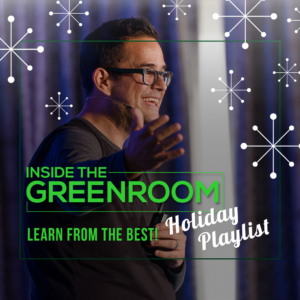We put together a “holiday playlist” for you, featuring 8 of our TOP episodes from Inside the Greenroom!
These episodes feature some of the world’s TOP meeting planners, and are LOADED with information you won’t find anywhere else – and the perfect playlist to listen to as you travel for the holidays!
Our top 8 episodes from Inside the Greenroom…
Bari Baumgardner: “The Art Of Why – How Strategy Can Make Or Break Your Event
Get Bari’s 4-Part “Strategy First” approach to running profitable live events. Learn the key questions you must answer before starting to plan your events PLUS how to win stages as a beginning speaker.
Check out Bari’s Interview here!
Michael Hyatt: How I Overcame Stage Fright (And How You Can Too)
In this episode, we discuss how to overcome the fear of speaking, avoid the “road warrior” trap, and how to host a world-class live event. Michael Hyatt also shares his “double win” concept, which shows how it’s possible to win in both business and life, without having to sacrifice your family.
Check out Michael’s interview here!
Ryan Deiss: The Blueprint For Event Revenue
Ryan is the one who introduced me to the power of online stages, and he’s been a valuable mentor in my business. In this episode, we discuss the Top 4 Event Business models – and how you REALLY make money from events.
Check out Ryan’s interview here!
John Ruhlin: The ROI Of Gifting Small Gestures With Big Impact
Learn how to create wins for both the meeting planner and the speaker. John also shares the prospecting strategies, bartering fees, building relationships with clients, and small “ninja tips” that ultimately make a big difference.
Check out John Ruhlin’s interview here!
Chalene & Bret Johnson: Using Events To Create Raving Fans
Chalene and her husband, Bret Johnson, have built multimillion-dollar businesses and have been running events together for decades! In this episode, you’ll learn how they’ve created raving fans across multiple industries, how they select the perfect speakers for their events, and how to pick the right venue to host your own events.
Check out Chalene & Bret’s interview here!
Roland Frasier: How We Sold Our Event, And How You Can Too
In this episode, you’ll learn how to build a company you can sell. We also discuss how to create your events so that they become an asset.
Check out Roland’s interview here!
Jon Berghoff: How To Add A Zero To Your Paycheck Through Learning Environment With Jon Berghoff
Jon shows you how to run a new type of event that gets your audience engaged throughout the entire process, and has them leave wanting to come back for more. We discuss transforming the type of event from passive to active learning, crowdsourcing wisdom from event attendees, orchestrating the event to help people connect easier, and much more!
Check out Jon Berghoff’s interview here!
Daniel Tardy: How Dave Ramsey’s Team Fills High-Ticket Events
In this episode, we dig into the nitty-gritty details of what it takes to both FILL and RUN a world-class event – creating an experience that leaves people enthusiastically wanting to come back again and again, year after year.
Check out Daniel’s interview here!
Enjoy!







